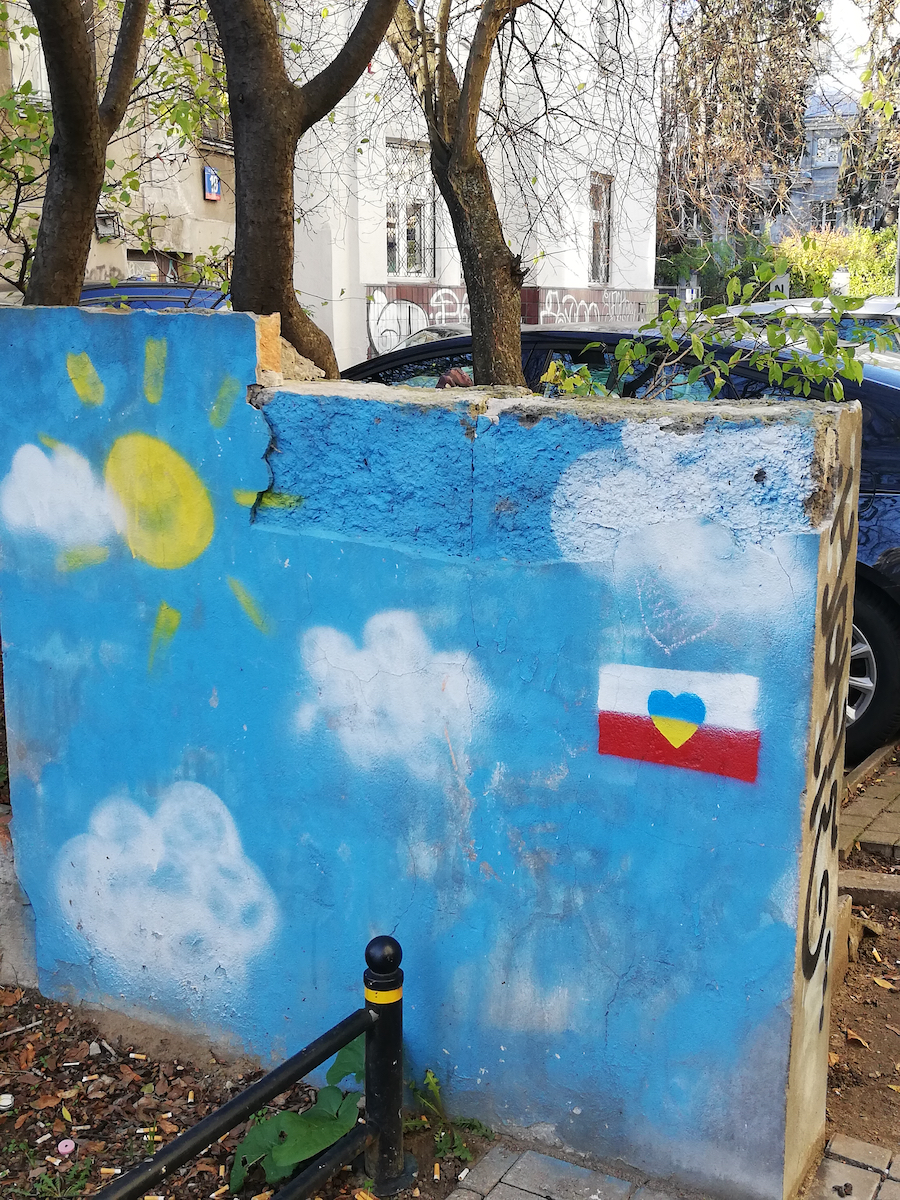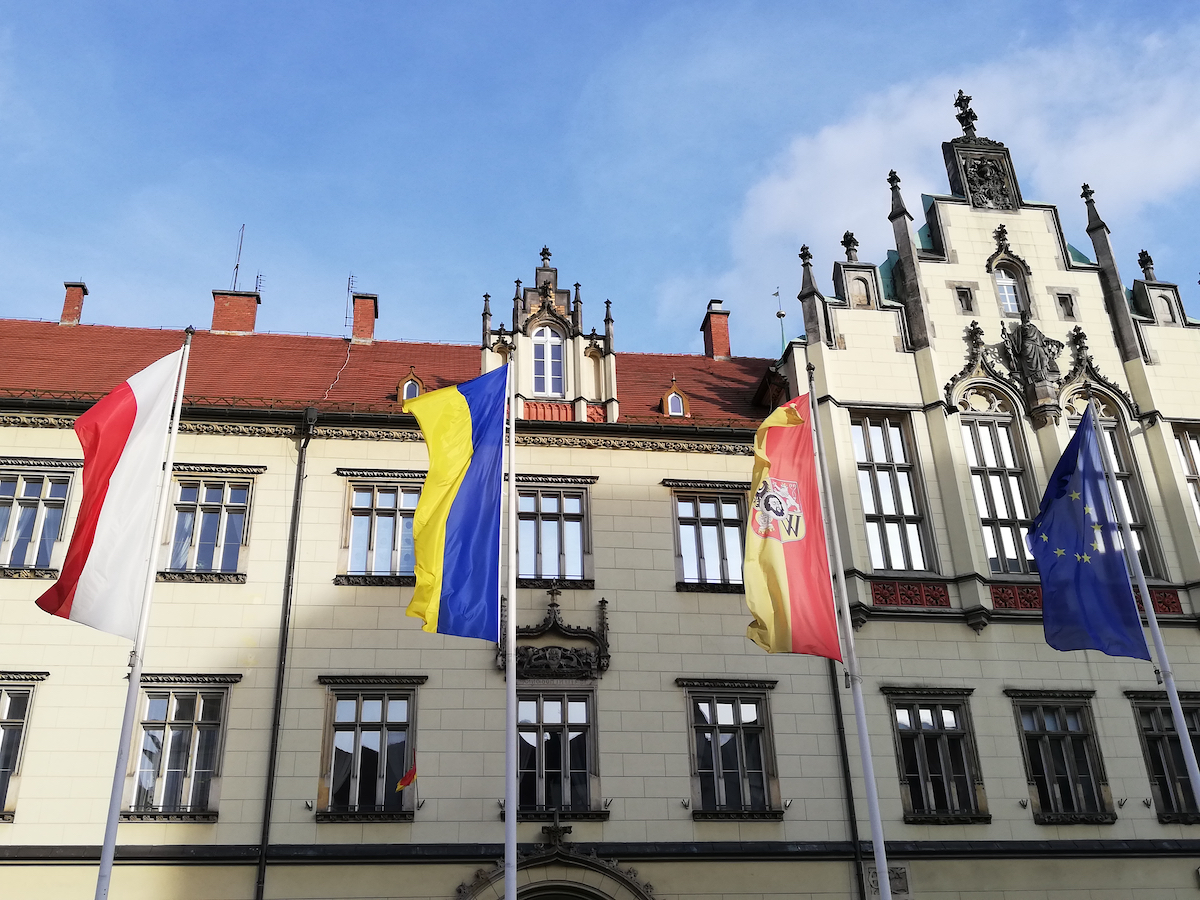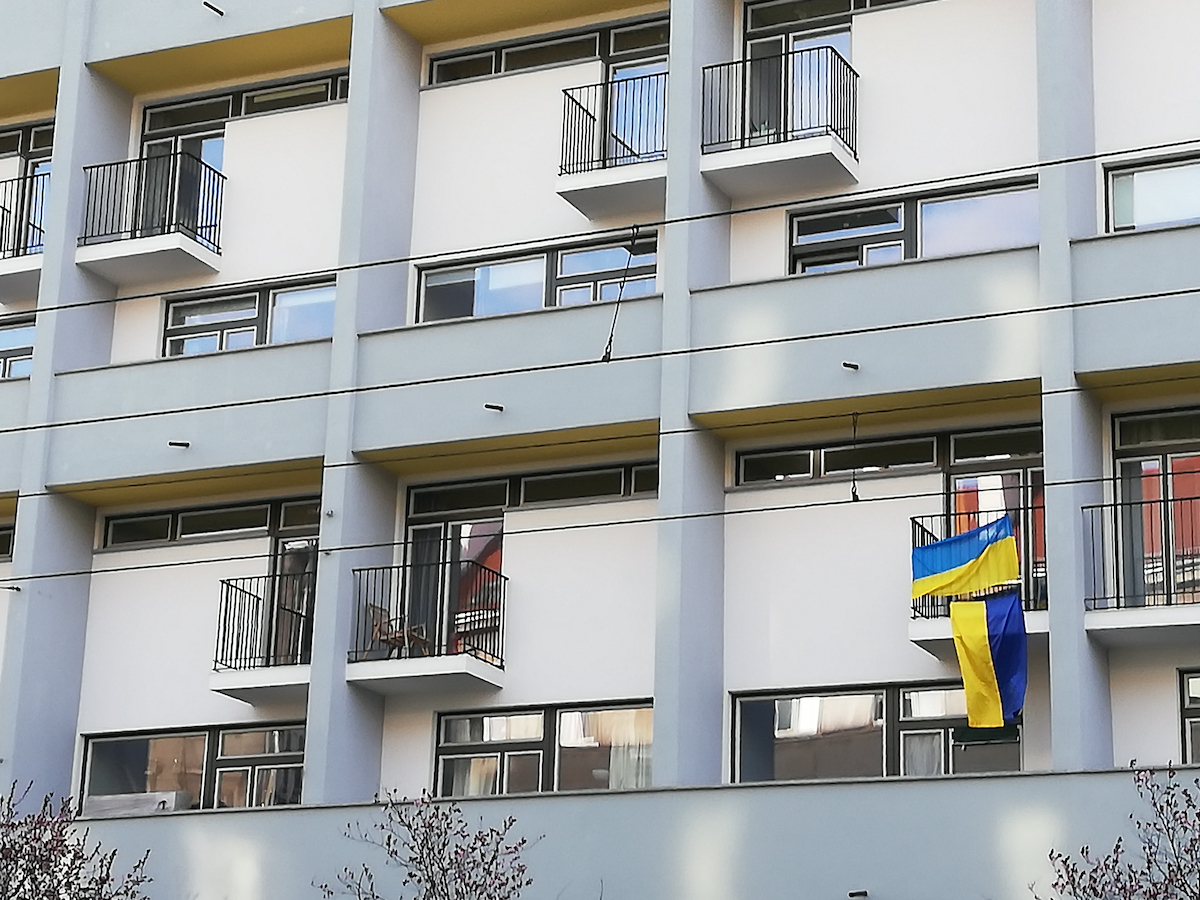How the Russian Invasion of Ukraine and Increased Number of Migrants Change the Status Quo
By Jolanta Steciuk
Summary: This article engages with the responses to the needs of migrants and war refugees in Poland in historical perspective. The article discusses the current refugee crisis resulting from the Russian invasion of Ukraine by contextualizing the politicization of migrations from different situations, including migrants and refugees on the Polish-Belarusian (e.g., Syrian and Afghans) and Polish-Ukrainian border. Finally, it considers the contemporary crisis of the rule of law, which has resulted in mainstreamed racism and ongoing discrimination against some categories of migrants.
Dominant Majority
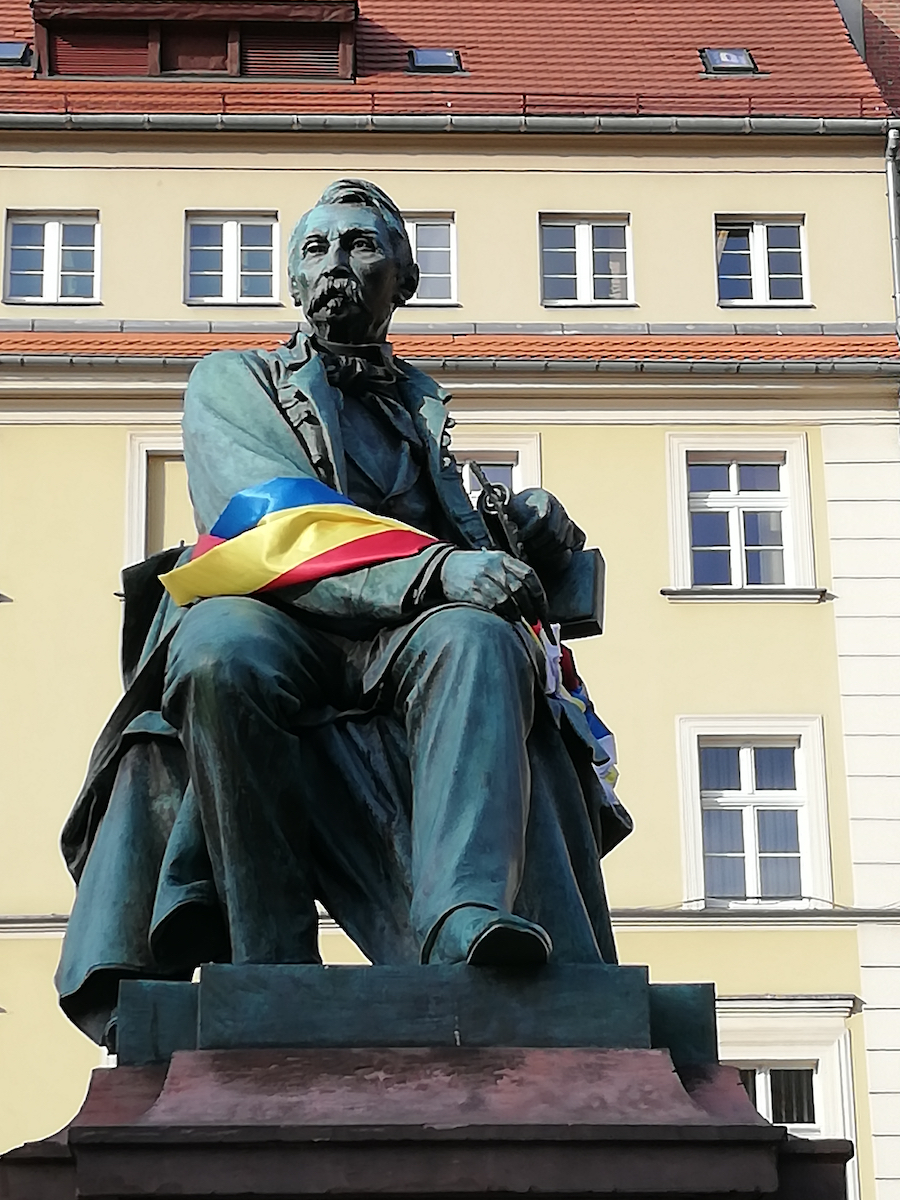
Monument to the Polish writer Aleksander Fredro in Wrocław was decorated with the flags of Poland and Ukraine, as a symbol of solidarity between Poles and Ukrainians after the Russian invasion of Ukraine. The monument was initially unveiled in 1889 in Lviv, and moved in 1946 from Lvic to Wrocław as a result of post-war territorial changes (annexation of eastern Poland by the Soviet Union, acquisition of prewar German territories by Poland in the aftermath of Potsdam Conference) and forced resettlements of Poles to the west.
Poland is often framed as a “homogenous country.” This phrase was created by the media in Poland to express the ethnic composition of the country after World War II. The dominant majority of citizens identify as ethnic Poles—as much as 94.83%, according to the 2011 census (the result of the 2022 census will be published in 2023). National minorities represent a tiny fraction of the society, with 1.55% declaring non-Polish identity, 2.26 % holding both Polish and non-Polish identity, and 1.35% considering themselves undefined.
In this sense, the postwar generations in Poland lacked a multicultural experience. However, the term “homogenous country” inexplicably refers to the change the war introduced. Before the Second World War, diversity was a norm: 31% of the population belonged to national minorities. According to the 1921 census, the main national minority group was Ukrainians (Ruthenians), representing 15.2% of the population, followed by Jews (8%), Belarusians (4%), and Germans (3%). The population change resulted from many factors, including the Holocaust; the death toll of the war and mass migrations; the annexation of the eastern, most ethnically diverse part of the country by the Soviet Union; and the shift of Polish borders based on the 1945 Potsdam Conference decisions.
The term “homogenous country” is a cliché imposing the perception of the current status quo as an “arrival point” in the country’s history. Though this view overlooks the changes, not only does it marginalize the existing minority groups on the level of language, it also does not take into consideration the growing number of immigrants to Poland.
Twenty-first Century: Poland’s Shift from Emigration to a Net Immigration Country
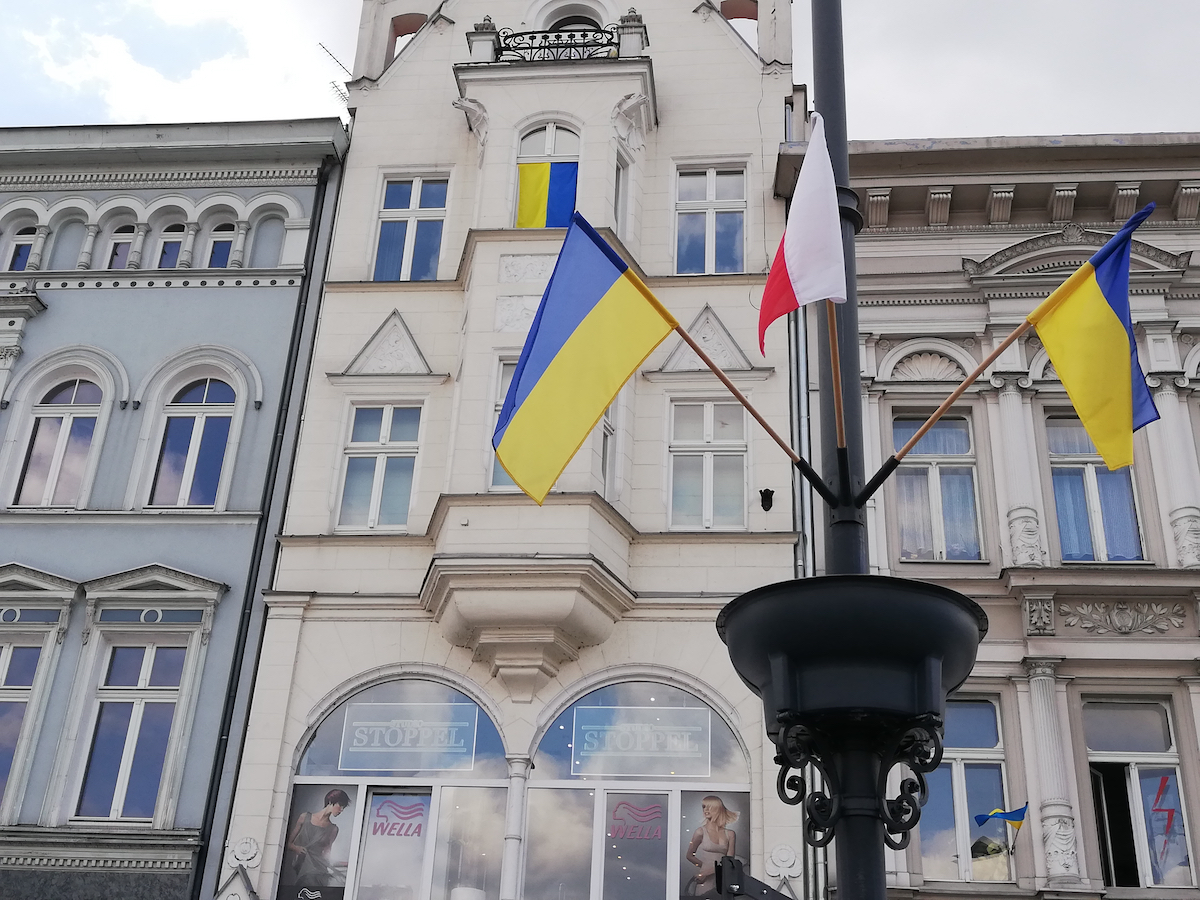
“For decades (and even centuries)” Poland used to be an emigration country, as pointed out in a recent report published by the Centre of Migration Research in 2023. The authors underline that over a decade ago, in 2010, “the number of foreigners living in Poland was very low (in terms of their share of the total population, it was one of the lowest of all EU Member States).” The report notes that Poland’s change of status to a net immigration country occurred only recently.
At the beginning of 2022, before the full-scale war in Ukraine, there were about 1.3-1.5 million Ukrainians living in Poland, mostly as economic migrants searching for better opportunities and integrating into the Polish labor market. In total, there were over 2 million immigrants in Poland at that time, reflecting other demographic changes over the past few years that are important to contextualize further.
2015: Increased Numbers of Asylum Seekers in Europe
“By the end of 2015, the EU as a whole received over 1.2 million first-time asylum claims, more than double the number registered in 2014 (563,000) … The increase in 2015 is largely due to higher numbers of asylum claims from Syrians, Afghans and Iraqis.” These migrants traveled through Southeast Europe and across the Mediterranean, fleeing war and instability. The phenomenon was called a “refugee crisis” due to the sudden increase in the number of people attempting to obtain asylum in Europe. In 2015, 853,000 migrants arrived in Greece, in comparison with about 34,400 people in the previous year, according to Global Migration Trends Factsheet 2015. The lack of infrastructure and often lack of willingness by European governments to address the humanitarian needs of migrants resulted in an unprecedented death toll of those crossing the Mediterranean Sea to reach European shores.
Populist leaders across Europe tried to play the anti-immigrant card in politics, including those in Great Britain (before Brexit and later too) and France. Anti-immigrant sentiments also increased in Eastern Europe. For example, in Poland, 53% of people were against refugees settling in the country as of December 2016, while in May 2015 there were only 23% of people expressing this opinion. When the EU discussed a relocation mechanism and the number of refugees to be settled in membership states in 2015, the Polish government declared its readiness to accept 2,000 refugees. However, Poland was criticized by other EU countries that had declared much higher numbers. When asked by the Public Opinion Research Center (CBOS) if Poland could take 9,000 refugees more, the vast majority (59% of people) said that it was far too much.
2022: Refugees on the Polish-Ukrainian Border

Commemoration of the victims from Bucza, Irpień, Krematorsk, Mariupol, Borodzinka in a public space
The full-scale Russian invasion of Ukraine in 2022 resulted in unprecedented migrations to neighboring countries. As of March 2023, the United Nations High Commissioner for Refugees (UNHCR) reported people from Ukraine have crossed the Polish-Ukrainian border over 10 million times. Some refugees from Ukraine went further west, others stayed in Poland for an undefined amount of time, and the remainder chose to return back after a couple of months to their country of origin. Either way, Poland—currently with a population of 38 million people—now faces a new reality. Refugees from Ukraine were welcomed with support, with the majority of Poles engaged in donating money and emergency goods, volunteering at train stations, offering free transportation, and hosting families in their homes. Additionally, the vast majority (over 90%) of Ukrainians living in Poland prior to the war actively engaged in these volunteer efforts as well.
The standard procedure in Poland and other European countries is to verify individual asylum applications and give refugee status based on the individual situation of a person. Even in 2015, when asylum seeker applicants in Germany accounted for about one-third of those across Europe, their applications were dealt with on a case-by-case basis. But in 2022, after the Russian invasion of Ukraine, the Polish government changed this approach when it comes to refugees coming from Ukraine. Building upon the hospitality of citizens who welcomed in these refugees, the government passed a law that dealt with the issue on a collective level. Ukrainian citizens that crossed the border after the Russian invasion of Ukraine were granted a work permit in Poland for the duration of 18 months, as well as access to education and health services equal to the ones enjoyed by the Polish citizens.
2021-2022: Refugees on the Polish-Belarusian border


Photo Caption (left): Poland, Białowieża Forest, Polish-Belarusian border, 2023. Photo Credit: Anna Kudarewska
Photo Caption (right): Poland, 2023. Cyril and Methodius Roman Catholic Church in Hajnówka town, close to Polish-Belarusian Border. The banner reads: “We would like to thank Polish soldiers and officers for defending the borders of the Republic of Poland.” The graffiti on the banner indicates Article 63 of the Border Guard Act. Article 63 indicates: “An officer is obliged to refuse to execute an order or other instruction if the execution of an order or other instruction would involve committing a crime.” Photo Credit: Anna Kudarewska
This compassionate approach towards Ukrainian refugees was in contrast to the response of Polish authorities to the humanitarian crisis that started in the previous year (mid-2021) at the Polish-Belarusian border. The Belarusian regime used migrations as a political tool to challenge the European Union (EU).
Since mid-August 2021, Grupa Granica (GG)—a collective of civil society organizations (CSO), made up of activists and local inhabitants responding to humanitarian crisis at the Polish-Belarusian border—has been providing humanitarian assistance to migrants from countries such as Iraq, Syria, Afghanistan, Yemen, Somalia, and Iran. GG has helped them access relevant legal procedures, and has monitored and documented law and human rights violations. People seeking protection were misled by the Belarusian regime to believe that they could use a safe route through the country into Europe, while in fact they found themselves trapped in the forests of the border zone. These migrants were pushed to Poland by Belarusian guards, while their refugee applications were not processed in Poland, with some exceptions only when human rights activists managed to intervene. They were then unlawfully pushed back by Polish border guards to Belarus and stuck in limbo.
A report by GG published in December 2021 reads, “We wish to emphasize that what is happening on the border between Poland and Belarus is not a migration crisis. The situation was not caused by any war, natural disaster or a sudden power shift within a region. People were brought to the border area by the Belarusian regime precisely to cause confusion and to generate polarization and conflict within the Polish society… We should remember that destabilization of the EU, which the Belarusian regime hopes to provoke, involves not so much “flooding” the EU with large numbers of migrants, but causing and reinforcing political divisions within Poland and the EU over the issue of how to receive migrants (the issue that divided European societies during the migration crisis of 2015-2016). Therefore, it is not the migrants, but political polarization that leads to destabilization.”
The report further comments on the response to the crisis by the Polish government: “The Belarusian authorities have easily managed to lead Poland into taking a series of radical steps: introducing the state of emergency, restricting freedom of media, banning activists from entering the border area, without exception for those providing medical and humanitarian aid. There has been a change in Polish legislation, which further affected human rights and the standards of human life protection. The strategy consists in pushing people who have crossed the border back to Belarus as quickly as possible and at all costs.”
Pushbacks and deaths of people on the move continue still today. As of March 2023, according to GG, at least 40 deaths have been confirmed in the Polish-Belarusian border area since the beginning of the crisis. Almost 300 people were reported missing.
Authors of the report “Polish School of Help. Reception of Refugees from Ukraine in Poland in 2022” also underline the difference between the refugee situations on the Polish-Belarusian and Polish-Ukrainian borders. As for the reception of refugees from Ukraine coming to Poland: “the Polish border is basically open to them.” The situation at the Polish-Belarusian border, which is “usually crossed by non-white people… fleeing from countries located further from Poland”—who are “equally, or sometimes even more, exposed to the threat to their life and health”—is different. But instead, the Polish government responded here “with deportations and [by] sealing the border (building a fence topped with razor wire, sending thousands of uniformed services to the border), which led to a serious humanitarian crisis. People fleeing to Europe in the hope of finding protection here were forced to hide in the border forests. They are caught in them by the Polish uniformed services and illegally and without complying with the procedures provided for by law, thrown into the territory of Belarus, where they meet with violence and torture.”
However, it is also important to mention cases of racism in the context of the situation of refugees fleeing from Ukraine. According to the European Commission, in the first weeks after the Russian invasion of Ukraine, “among the millions of people seeking refuge in the EU and neighbouring countries from Putin’s war, 100,000 are estimated to be Roma.” The report “Human Rights, Needs and Discrimination – The Situation of Roma Refugees from Ukraine in Poland” underlines: “Roma from Ukraine constitute a particular group of refugees due to their experience of discrimination in Ukraine and subsequently in Poland… These include both verbal and non-verbal acts of discrimination and/or social and cultural exclusion from resources available to refugees: housing, jobs, information, transport, material resources, and psychological, legal and educational support.”
2023: Instead of Conclusions

The cliché of Poland as a “homogenous country” was perceived for decades as the arrival point of the nation’s history. Diversity was thought of as a past experience, regardless of the continuously significant presence of economic immigration. Despite the ethically problematic nature of such judgments, different sections of Polish society hold different opinions of “what is better” in terms of homogeneity or diversity.
During the last decades, various geopolitical experiences influenced the approach to “others” and the perception of diversity: the fall of communism and democratization, EU enlargement and freedom of movement within the block, the Syrian war and mass migrations in Europe in 2015, and war in Ukraine (2014, 2022). In each case, media coverage or restricted freedom of media played a significant role in shaping narratives, fueling emotions, and forming opinions.
The global peacebuilding community needs to be especially aware of the growing number of migrants’ deaths at the Polish-Belarusian border, as well as on other EU borders. Normalization of this process in public discourse leads to the dehumanization of the people on the move. To offer support in this ongoing situation, global peacebuilders can:
- Raise awareness of the fact that humanitarian activists who help migrants at the Polish-Belarusian border face repression, including verbal aggression, physical violence, and criminal charges;
- Protest against criminalization of solidarity with migrants and asylum seekers in Poland and other countries in Europe, as well as support individuals affected;
- Support humanitarian activists by responding to their calls for financial support and by sharing their reports documenting human rights violations;
- Counteract racism in their respective countries and globally, as racism causes human rights violations in peacetime, but especially in times of war.
About the Author
Jolanta Steciuk is a graduate of the Faculty of Law at the University of Warsaw. As a scholarship holder at Columbia University in New York, she participated in the Alliance for Historical Dialogue and Accountability fellowship program (2012). She is a team member of Migrant Academy in Poland and a trainer in international projects on history, memory, and reconciliation carried out at the Krzyżowa Foundation for Mutual Understanding in Europe. She is the author of a published interview with Halina Bortnowska Wszystko będzie inaczej (2010).


